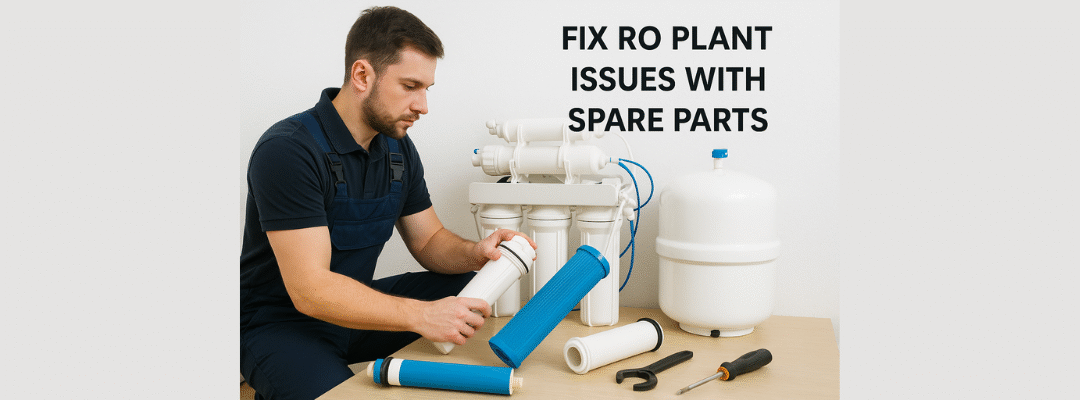Reverse Osmosis (RO) water plants are essential in ensuring safe, purified water across homes, industries, hospitals, and hotels. However, like any filtration technology, they require consistent maintenance. Without regular servicing, issues like low output, bad taste, or even breakdowns can compromise water quality and system efficiency.
This guide will walk you through the most common RO water plant problems, their causes, practical fixes, and essential maintenance tips to keep your system running optimally.
Why Regular RO Maintenance Is Critical
Proper maintenance helps:
- Ensure consistent purity and ideal TDS levels
- Prolong the life of filters and membranes
- Prevent scaling and microbial growth
- Lower energy use and repair costs
- Maintain compliance with safety and industrial standards
Neglecting these tasks can lead to costly breakdowns, water quality violations, and unscheduled downtime in high-demand environments like hospitals or food plants.
Common RO System Problems and Their Solutions
Low Water Output or Flow
Causes:
- Clogged pre-filters or carbon filters
- Fouled or scaled membranes
- Low feed water pressure
- Blocked flow restrictor
Fixes:
- Replace pre-filters every 6–8 months
- Clean or replace membrane if pressure drops persist
- Ensure pump pressure is optimal (100–150 PSI for industrial systems)
- Unblock or replace the flow restrictor
Unpleasant Taste or Odor
Causes:
- Worn-out carbon filter
- Bacterial growth in storage tank
- High TDS due to degraded membrane
Fixes:
- Replace carbon filter every 6–12 months
- Clean and disinfect storage tanks regularly
- Test TDS and replace membrane if levels exceed standards
Continuous Pump Running or No Auto-Shutoff
Causes:
- Malfunctioning float switch or pressure sensor
- Leakage in pipelines or fittings
- Faulty solenoid valve
Fixes:
- Replace or calibrate sensors and switches
- Check for leaks in pipe joints
- Clean or replace solenoid valve
High TDS in Output Water
Causes:
- Membrane wear or fouling
- Leaky O-rings in membrane housing
- Misaligned bypass or valves
Fixes:
- Replace or clean membrane
- Check and reseal all O-rings
- Adjust valves for proper reject/recovery ratio
Excess Wastewater / Low Recovery
Causes:
- Incorrect flow restrictor ratio
- Scaled or dirty membranes
- High feed TDS or hardness
Fixes:
- Use proper restrictor (1:3 for domestic, 1:2 for industrial)
- Perform chemical cleaning (CIP)
- Install softener or antiscalant dosing system
Noise or Vibrations in System
Causes:
- Airlock in the pipeline
- Loose fittings or mountings
- Faulty pump bearings
Fixes:
- Bleed air from the lines
- Tighten loose fittings
- Lubricate or replace bearings
Foul Smell or Biofouling in Membrane
Causes:
- Bacterial growth from stagnant water
- Irregular flushing and cleaning
Fixes:
- Run CIP with chlorine-based cleaners every 1–2 months
- Enable auto-flush after shutdowns
- Avoid keeping RO inactive for long periods
Preventive Maintenance Checklist
| Task | Recommended Frequency |
|---|---|
| Replace pre-filters | Every 6–8 months |
| Replace carbon filter | Every 6–12 months |
| Clean/replace RO membrane | Every 12–24 months |
| CIP (chemical cleaning) | Every 3–6 months |
| TDS & flow testing | Monthly |
| Sanitize storage tank | Quarterly |
| System-wide disinfection | Biannually |
Expert Tips to Extend RO System Life
- Monitor TDS levels regularly
- Avoid long idle periods
- Maintain correct pressure and pH input
- Use high-quality filters and consumables
- Schedule professional servicing every 6 months
- Maintain a digital log of system performance and servicing
When to Call a Professional Technician
If you notice:
- Consistently high TDS in output water
- System leaking or losing pressure
- Pump not stopping or excessive vibration
Call a certified RO technician to:
- Perform CIP chemical cleaning
- Inspect and replace membranes
- Calibrate pressure and sensors
- Run SCADA/PLC diagnostics if automated
FAQs: RO Maintenance Made Simple
Q1. How often should RO membranes be cleaned?
Every 3–6 months depending on usage and feedwater quality.
Q2. Why is my RO system output low?
Blocked filters, fouled membranes, or weak pump pressure are likely causes.
Q3. Can bad odor come from RO water?
Yes, if the tank is not sanitized or carbon filters are expired.
Q4. How long does an RO system last?
Industrial units can last 8–10 years with proper maintenance.
Q5. What is CIP in RO systems?
Clean-In-Place – a chemical cleaning method to remove scale and biofouling from membranes.


Recent Comments